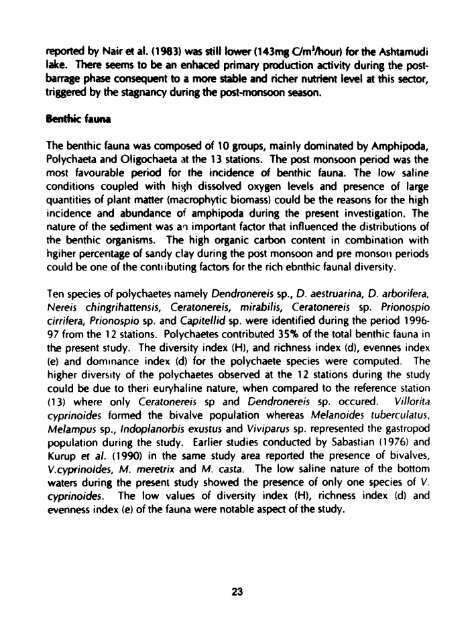e - poz 2 - Central Institute of Brackishwater Aquaculture
e - poz 2 - Central Institute of Brackishwater Aquaculture
e - poz 2 - Central Institute of Brackishwater Aquaculture
You also want an ePaper? Increase the reach of your titles
YUMPU automatically turns print PDFs into web optimized ePapers that Google loves.
eporxd by Nair et al. (1983) was dill lower (143mg Um3/hour) for the Ashtamudilake. There seems to be an enhaced primary production activity during the postbarragephase consequent to a more stable and richer nutrient level at this sector,triggered by the stagnancy during the post-monsoon season.The benthic fauna was composed <strong>of</strong> 10 groups, mainly dominated by Amphipoda,Polychaeta and Oligochaeta at the 13 stations. The post monsoon period was themost favourable period for the incidence <strong>of</strong> benthic fauna. The low salineconditions coupled with hish dissolved oxygen levels and presence <strong>of</strong> largequantities <strong>of</strong> plant matter (macrophytic biomass) could be the reasons for the highincidence and abundance <strong>of</strong> amphipoda during the present investigation. Thenature <strong>of</strong> the sediment was aq important factor that influenced the distributions <strong>of</strong>the benthic organisms. The high organic carbon content in combination withhgiher percentage <strong>of</strong> sandy clay during the post monsoon and pre monson periodscould be one <strong>of</strong> the contlibuting factors for the rich ebnthic faunal diversity.Ten species <strong>of</strong> polychaetes namely Dendronereis sp., D, aestruarina, D. arborifera,Nereis chingrihanensis, Ceratonereis, rnirabilis, Ceratonereis sp. Prionospiocirrilera, Prionospio sp. and Capitellid sp, were identified during the period 1996-97 from the 12 stations. Polychaetes contributed 35% <strong>of</strong> the total benthic fauna inthe present study. The diversity index (HI, and richness index (d), evennes index(e) and dom~nance index (d) for the polychaete species were computed. Thehigher divers~ty <strong>of</strong> the polychaetes observed at the 12 stations during the studycould be due to theri euryhaline nature, when compared to the reference station(13) where only Ceratonereis sp and Gendronereis sp. occured. Villoritacyprinoides formed the bivalve population whereas Melanoides tuberct~latus,Melarnpus sp., lndoplanorbis exustus and Viviparus sp. represented the gastropodpopulation during the study. Earlier studies conducted by Sabastidn (1976) andKurup et a/. (1990) in the same study area reported the presence <strong>of</strong> bivalves,V.cyprinoides, M. meretrix and M. cas~a. The low saline nature <strong>of</strong> the bottomwaters during the present study showed the presence <strong>of</strong> only one species <strong>of</strong> V.cyprinoides. The low values <strong>of</strong> diversity index (HI, richness index (d) andevenness index (e) <strong>of</strong> the fauna were notable aspect <strong>of</strong> the study.

















